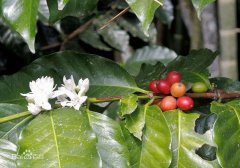Coffee extraction principle = chemical reaction + physical reaction?!
UESTION
Hi! Emma!
I keep hearing people talk about "hydrolysis" in the brewing process of coffee. What is it? Can you explain the scientific basis of "hydrolysis"? What's the difference between it and extraction? Thank you!
A drunk coffee man in Baltimore
ANSWER
Dear people who are drunk with coffee in Baltimore:
I feel your pain! Coffee brewing is one of the most complex topics in the coffee industry, but people don't seem to pay much attention to it. In the core extraction theory of SCAA put forward by Ted Lingle (Ted Ringer) in 2011, we SCAA as a whole has made it clear that the whole coffee brewing is divided into three stages: wetting-extraction-hydrolysis (chronological sequence). These words seem to be quite professional, but in fact, SCAA still does not have the ability to give them a very accurate definition. When the theory is vague, you baristas are confused, and there must be the kind of questions you ask.

Let's take a look at the extraction. When the coffee powder has been wetted by high temperature, the gas and lively gas compounds first escape, and the soluble organic molecules inside the coffee are "pulled" into the water by osmotic pressure at the same time, and then dissolved. This process is mainly caused by a series of chemical and physical changes caused by the contact of coffee powder with hot water, which we call "extraction". But in fact, the word "extraction" can also be confused with "brewing", because extraction is indeed the longest and most influential part of coffee brewing.
When chemists use the word "extraction", they mean the process of separating a particular compound from a mixture. What is this definition used in coffee? We need to "separate" the organic molecules that make up the coffee liquid from the coffee powder. When a substance comes into contact with a solution, such as water, we classify it as soluble and insoluble. In coffee brewing, the solute (coffee ingredient) contained in coffee powder, and water is the universal solution. In fact, without the process of "extraction", we would never drink coffee, only a mixture of coffee grounds and water. In fact, the "extraction" link can also be subdivided into several sub-reaction processes. It is related to water temperature, extraction time, stirring degree and so on. In the process of extraction, coffee powder has been undergoing many kinds of physical and chemical reactions.

The "hydrolysis" you mentioned earlier is one of the many "extraction" sub-reactions. In coffee extraction, when water comes into contact with an insoluble large organic molecule and has a "chemical reaction" with it (rather than a physical reaction) to decompose and dissolve it, this is hydrolysis. Insoluble macromolecules are insoluble, but the heat carried by hot water causes them to react with water, and the tough structure of the macromolecules seems to be slowly "washed" by water to become soluble components.

The second sub-chemical reaction is "dissolution". The soluble molecules in coffee powder dissolve in water, making the water into coffee liquid. It includes the following soluble molecules: organic acids such as chlorogenic acid, acetic acid and malic acid, as well as caffeine and trigonelline. There are two different types of dissolution, one is the dissolution of molecules, the other is the dissolution of ions. Salts and acids tend to dissolve in ionic form, while organic molecules such as caffeine dissolve in molecular form. When water comes into contact with coffee powder, the dissolution process occurs spontaneously.

The third reaction is diffusion. When a solute is dissolved in a solvent, the solute density is often not the same in every part of the solvent. When the solute density in the two regions is different, the solute (ions, molecules) will transfer from the high density place in the solution to the low density place. In coffee extraction, this means that the substance is transferred from coffee powder (with high concentration) to water (with almost zero concentration). The most typical example of diffusion is infiltration of Osmosis. Osmosis is the spontaneous passage of soluble molecules through the membrane (cell membrane level), from the high concentration end to the low concentration end, which will eventually make the two segments of the membrane have the same liquid concentration. Diffusion does not require any stirring or scouring, not even the gravity of water on the coffee powder, as long as the water (solvent) comes into contact with the coffee powder (the internal solute).

This is the whole process of coffee extraction, regardless of the time in which it happened, the "hydrolysis" you want to know belongs to the first part, please don't get confused.
For those who want drunk coffee, Emma
Emma Bladyka

Head of coffee research at SCAA. Before joining the coffee industry, she received a bachelor's degree in environmental science and botany, as well as a minor degree in red wine research. She hopes to pass on her research on coffee to all coffee lovers.
Important Notice :
前街咖啡 FrontStreet Coffee has moved to new addredd:
FrontStreet Coffee Address: 315,Donghua East Road,GuangZhou
Tel:020 38364473
- Prev

What potential does it take to become a top barista?
1. If there is a goal, there is passion and there is no success without it. We need to set a goal for life and strive for it all our lives. Have you ever asked yourself what the purpose of becoming a barista is? Is it to make perfect coffee, create new drinks, or spread boutique coffee knowledge to the public? Be sure to find your goal in life and keep fighting for it.
- Next

Ten movies about coffee
Coffee and cigarette Coffee and Cigarettes this is a collection of short films made up of eleven short stories. Each short film revolves around cigarettes and coffee, but not around these two objects. 1. Roberto Benini was sitting in a cafe drinking coffee when Steve Wright came to talk to him, but the two seemed to have nothing in common and were just repeating their watches
Related
- Beginners will see the "Coffee pull flower" guide!
- What is the difference between ice blog purified milk and ordinary milk coffee?
- Why is the Philippines the largest producer of crops in Liberia?
- For coffee extraction, should the fine powder be retained?
- How does extracted espresso fill pressed powder? How much strength does it take to press the powder?
- How to make jasmine cold extract coffee? Is the jasmine + latte good?
- Will this little toy really make the coffee taste better? How does Lily Drip affect coffee extraction?
- Will the action of slapping the filter cup also affect coffee extraction?
- What's the difference between powder-to-water ratio and powder-to-liquid ratio?
- What is the Ethiopian local species? What does it have to do with Heirloom native species?

